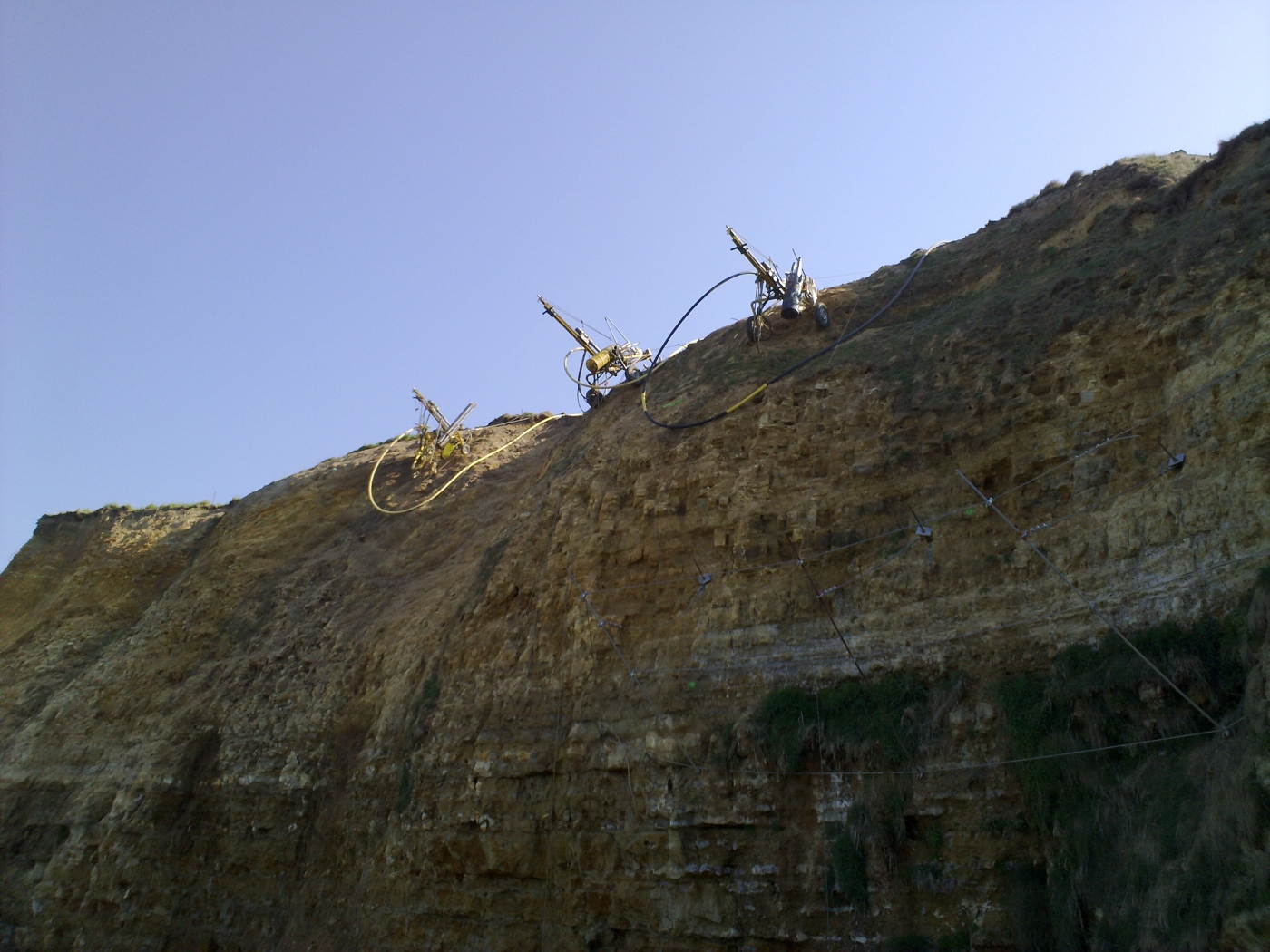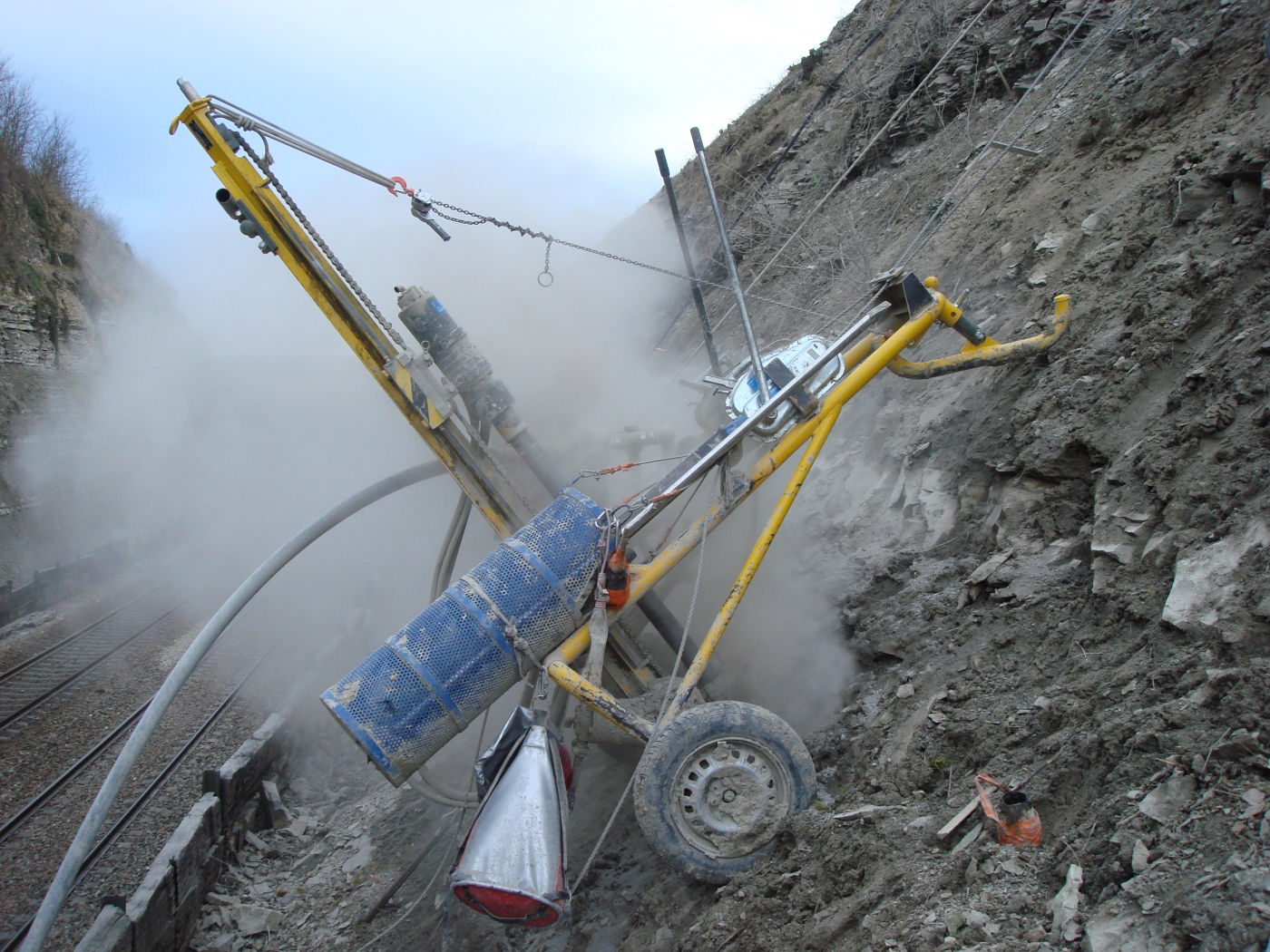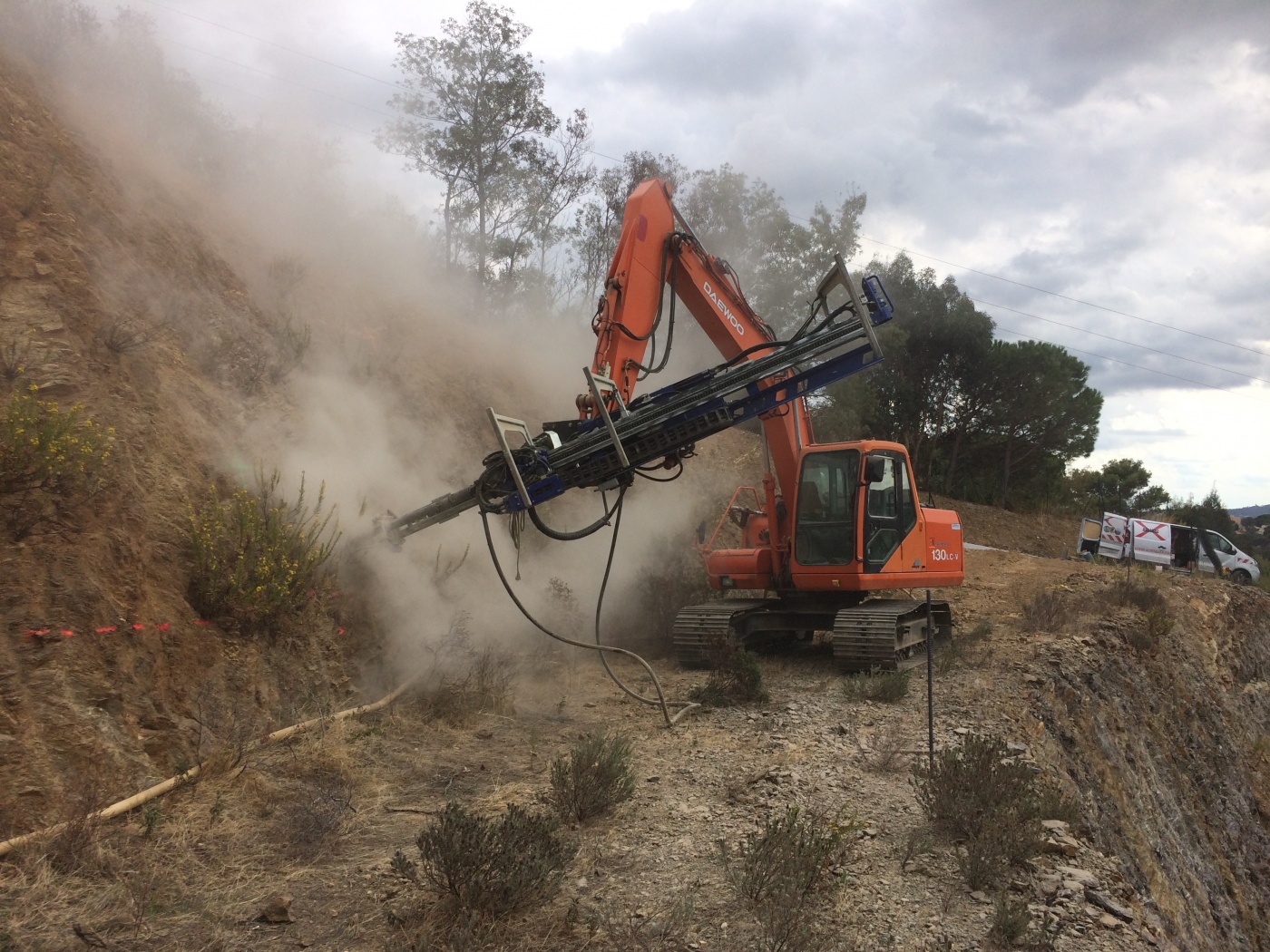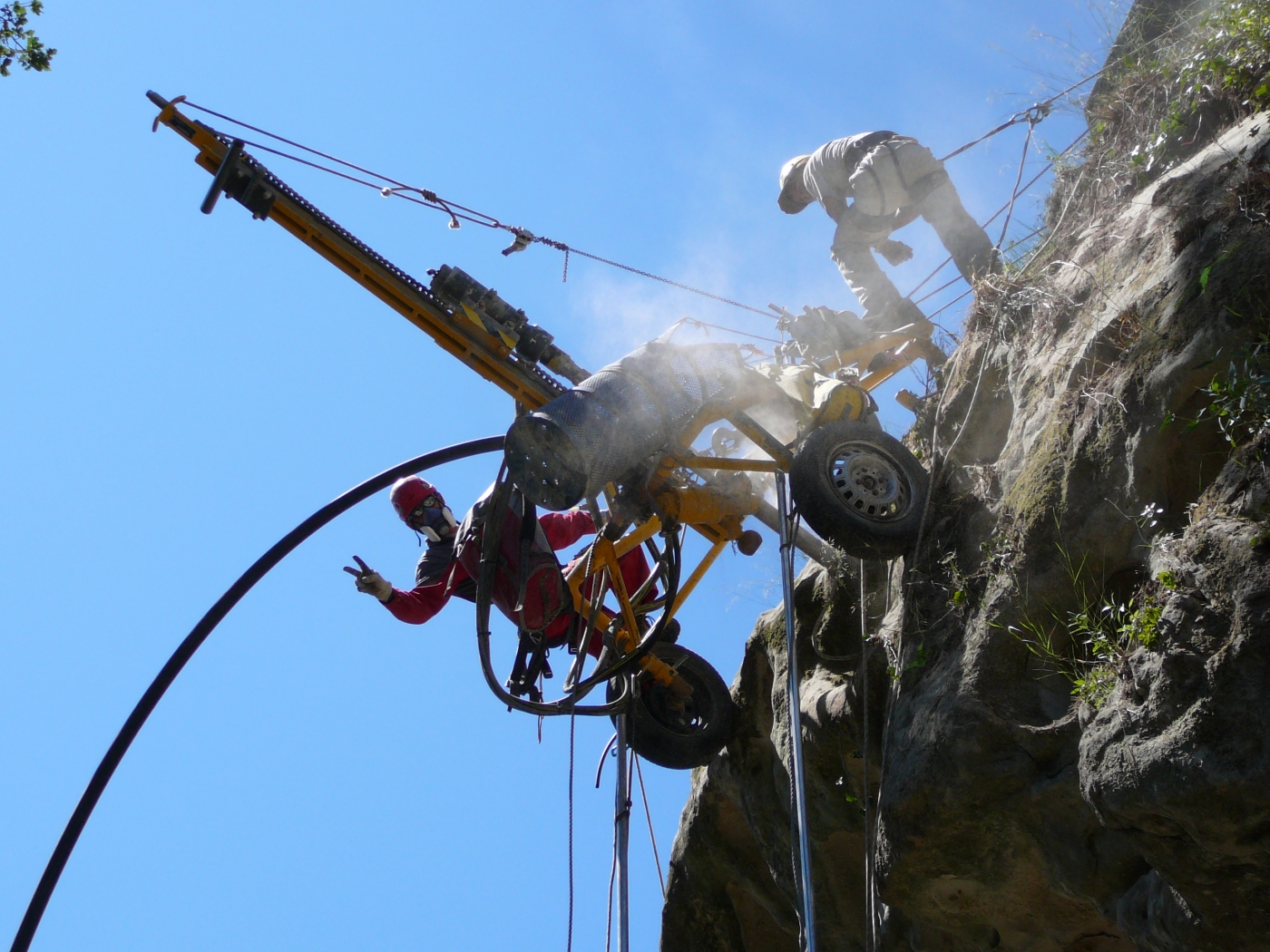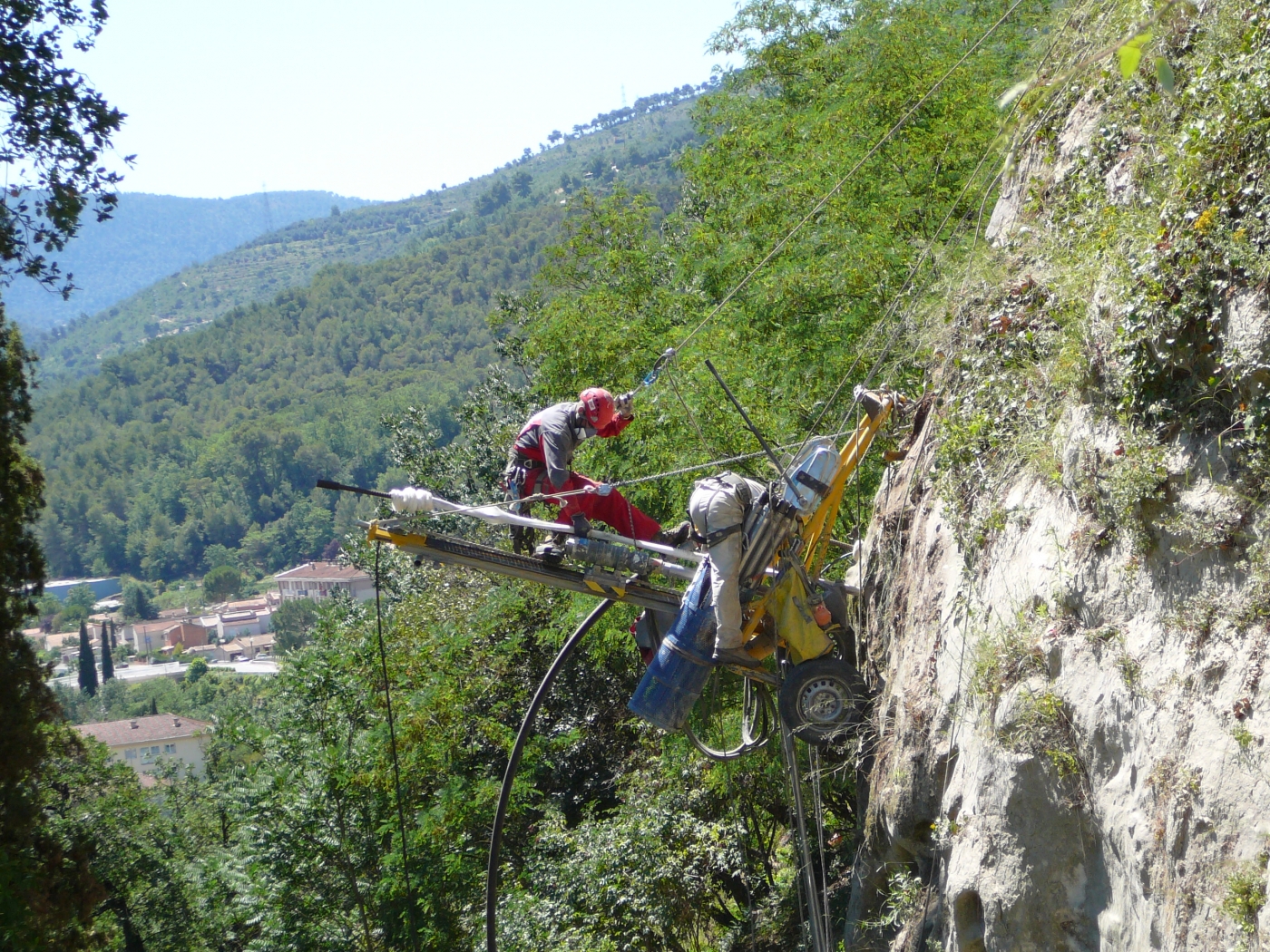Which techniques do anchors require?
Anchors via a technical procedure, through the inserting of a hole (by all boring methods adapted to the dimensions of the ground in question), the introduction of a threaded metal framework (or synthetic) or sealing this to the support (rock/soft ground), an anchor head made of a plate and a visible nut which allows a definitive clamping of the anchor.
Anchors are the core of our work then the anchors are used to fix elements of protection worksplated mesh , hanging mesh / ASM / stone screens, block screens, avalanche covers / canvas wire, rope canvas…) or used to directly reinforce the unstable rock.
The performance of protective works and/or reinforcement is directly dependent on the anchors which form them being perfectly placed. The length and diameter of the preliminary boring necessary must be calculated by an office of geotechnical study via a specific study and suitability tests (destructive pull-out test for the suitability of the anchor establish the resistance of the group where the anchor is going to be placed).
The nails and tie rods for anchoring
When using anchors, there are essentially two different names which characterize the need for or use of anchors and relate to two different norms.
Nails for direct nailing
We talk about nails (application of the France’s Clouterre recommenations) for direct nailing (fixing works, reinforcing, passive anchors, systematic nailing for soil nailing or dry soil nailing) where the complete length of the boring hole and the framework are sealed.
Tie rods for clasping
Otherwise, we talk about tie rods (application of TA norm 95) often used for the clasping of a zone between two sealed areas and the area of the anchor head torqued as the geotechnical studies have defined. As such, the tie rod naturally leads to a non-sealed area, which is assessed to be better if compressed. This is so pressure between the anchor head and the sealed downhole area compresses and stabilizes the non-sealed ’empty’ area. The length of the tie hold is highly variable, from several meters to several dozen. By the same token, the non-sealed length can also be varied, from a thickness of close to zero up to dozens of meters. The anchors are sealed via pure cement grout (cement + water). They can be equipped in adance with a geotextile ‘sock’ which limits the loss of grout for terrain where there is the present of gaps or fissures/faults. To limit loss, the injection can also be carried out through finish mortar.
Boring techniques to apply anchors
To apply anchors directly, there are multiple techniques. It is important to master them and choose the most approrpiate one, best adapted to the area to be bored:
Boring with a rotary percussion destroyer, removing the shreddings with compressed air
Drilling with a rotary percussion destroyer is the traditional method for removing shreddings (drill dust due to the destruction of the earth during drilling) by compressed air is the most frequently-used “traditional” technique for cohesive ground (walls with boreholes). This technique can be carried out with boring machines hammer in the hole or down-the-hole hammer and consists of destroying the ground to the diameter desired by rotary percussion of the bit and removing the dust produced by compressed air (portable compressor). This moves out of the hollow rods and then the holes present on the bit, meaning the compressed air can directly exit the bottom of the hole to push the shredding out. The anchors are sealed via pure cement grout (cement + air). They can be equipped in advance with a geotextile ‘sock’ which limits the loss of grout at ground where there is the presence of gaps or fissures/faults. To limit loss, injection can also be carried out through finish mortar. This is the lowest-cost technique which allows for proper performance according to the strength of the machines used. However, it is necessary that the ground ‘takes’ them.
Self-drilling (rotary percussion destroyer with continuous injection)
Drilling with a rotary percussion destroyer with continuous injection is also called ‘self-drilling’ or ‘no bars and bits’. This technique is suitable for soft, collapsible ground, which has weak cohesion and where the walls cannot hold boreholes drilled by traditional techniques. As such this tool is perfect to avoid boreholes collapsing, guarantee a consistent boring diameter and ensure perfect sealing for mediocre or even bad ground. It is hardly more expensive than ‘traditional’ techniques and the grounds for using this technique are multiple. Using continuous ejections of cement grout (to cool the bit and blend the material destroyed without the grout) does not only effect injections into ground for possible gaps (expanded terrain) which can be seen as improving loose soil. However, by the fact of blending destroyed material with the grout, a coefficient expansion of 1.2 in relation to the diameter of the standardly used drill can be seen. This means the borehole no longer forms a perfect cylinder (like a hole in rock). It forms instead, at pullout, a high-value bulb. The negative aspects of this technique are that it is essential to constantly inject fluid so as to cool the bit (as such there is an additional injection post) or run the risk of ‘melting’ and not be able to go further into the hole or make an exterior injection (not desired) impossible in that the bit is completely destroyed. This technique is recommended for boring directly into rock because no bit, even a carbide one, can maintain resistance after two or three ml of boring into rock of average to tough character. On the contrary, it is very useful to adopt this technique when working across embankments or soft ground to finish a hole and seal the rock. Using soil nailing is common and is the best alternative to a cased wellbore. This is to minimize the risk of the loss of the injection grout into ground where there are significant gaps. These gaps indicate coating of the framework and can also lead to weak points in the framework with time and corrosion.
Boring with tubed rotary percussion destructor removing shreddings via compressed air
The technique used most frequently in earth with low cohesion (walls which do not hold boreholes) is boring with tubed rotary destructor with removing shreddings (drill dust due to the destruction of the ground when foraging) by compressed air. This is also technically known as ‘ODEX’ or wellbore’ or ‘progressive tubage’. This technique can be realized by powerful hydraulic drilling machines (high torque) equipped with down-the-hole hammers. It consist of breaking the ground at the desired diameter via the bit’s rotary percussion and removing the dust produced by compressed air (portable compressor). This moves out of the hollow rods and then the holes present on the bit, meaning the compressed air can directly exit the bottom of the hole to push the shreddings out and the same time draw a progressive tube back in. Progressive tubing has the goal of mechanically ‘holding’ the walls for boreholes until the hole has been complete. It is for example possible to ‘tube’ a soft area and extend the boring if necessary into rock without tubing to attain the required sealing of the rock. The hollow rods and bit are withdrawn and the provisional or final tubing location maintained. The metal threaded framework is then introduced into the tubing with no risk of collapse in the borehole walls, and next comes the injection during the progressive withdrawal of the tubing. It’s also possible to leave the tubing in, which method is known as ‘lost tubing’. The anchors are sealed via pure cement grout (cement + air). They can be equipped in advance with a geotextile ‘sock’ which limits the loss of grout at ground where there is the presence of gaps or fissures/faults. To limit loss, injection can also be carried out through finish mortar. This is the most expensive drilling method. It creates high-quality sealing for weaker areas and at soft, non-guaranteed ground that requires need powerful hydraulic drilling. The withdrawal during the injection risks the loss of the injection grout which leads to bad framework coating. This can also lead to weak points in the framework with time and corrosion.


